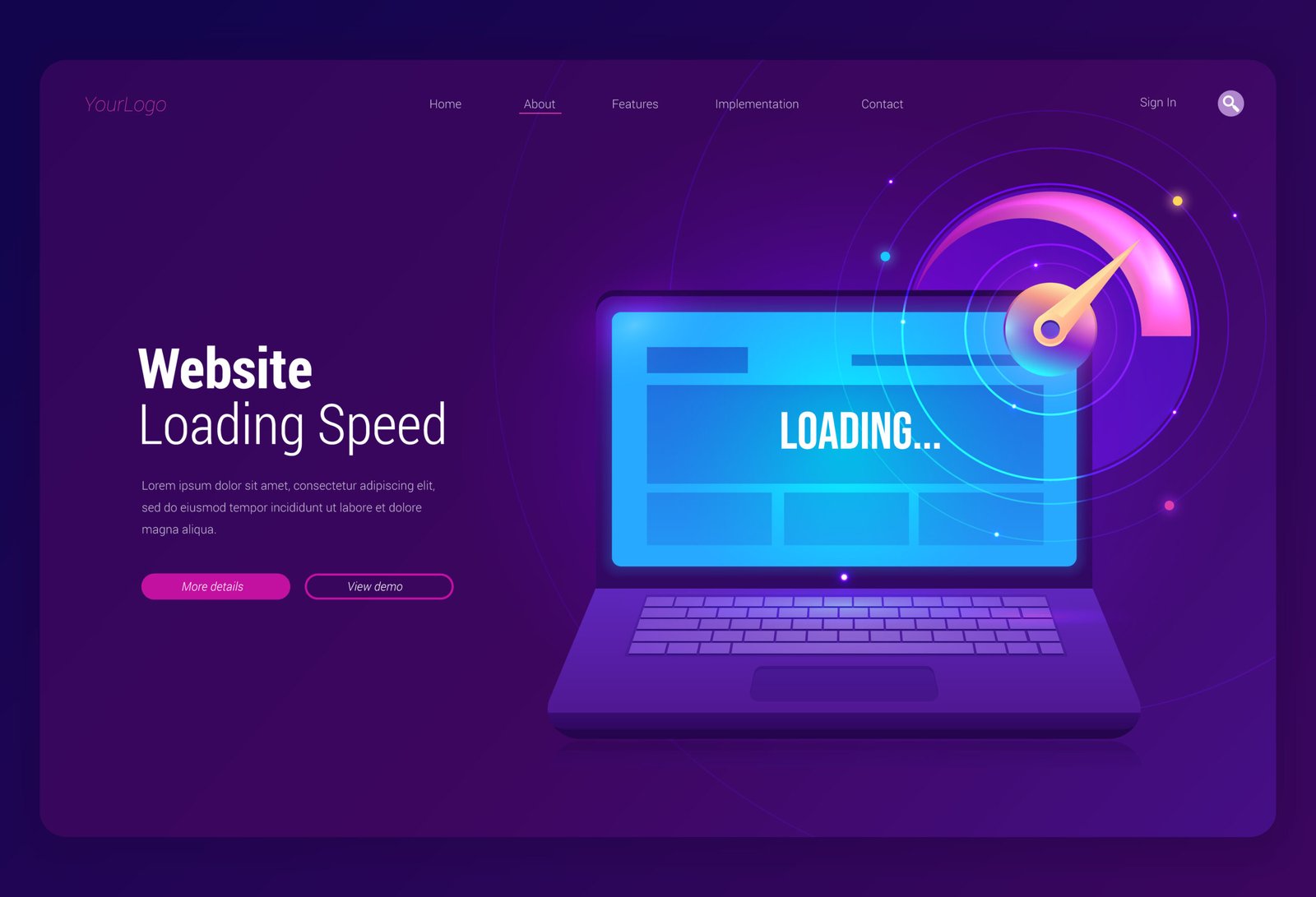
Website speed isn’t just a nice-to-have feature—it’s a critical business requirement. In 2025, users expect websites to load in under 3 seconds, and search engines like Google use page speed as a ranking factor. A slow WordPress site can cost you customers, search rankings, and revenue.
Studies show that a 1-second delay in page load time can reduce conversions by 7%, page views by 11%, and customer satisfaction by 16%. For e-commerce sites, even a 100-millisecond delay can hurt conversion rates by 1%.
The good news? WordPress speed optimization is achievable with the right techniques and tools. In this comprehensive guide, we’ll share 12 proven methods to dramatically improve your WordPress site’s performance and give your business the competitive edge it needs.
Why WordPress Speed Matters for Your Business
Search Engine Rankings:
Google’s Core Web Vitals update made page speed a direct ranking factor. Faster sites rank higher in search results, driving more organic traffic to your business.
User Experience:
Fast-loading websites provide better user experiences, leading to lower bounce rates, higher engagement, and increased time on site.
Conversion Rates:
Speed directly impacts your bottom line. Amazon found that every 100ms of latency cost them 1% in sales. For most businesses, improving site speed by just 1 second can increase conversions by 2-7%.
Mobile Performance:
With mobile traffic accounting for over 60% of web browsing, mobile speed optimization is crucial for reaching your audience effectively.
How to Test Your WordPress Site Speed
Before optimizing, you need to know your current performance. Use these free tools to test your site speed:
Google PageSpeed Insights: Provides detailed performance analysis and specific recommendations for improvement.
GTmetrix: Offers comprehensive speed reports with actionable insights and performance grades.
Pingdom: Simple speed testing with geographic location options to test from different regions.
WebPageTest: Advanced testing with detailed waterfall charts and performance metrics.
Test your site from multiple locations and devices to get a complete picture of your performance. Record your current scores to measure improvement after implementing these techniques.
1. Choose a Fast WordPress Hosting Provider
Your hosting provider is the foundation of your website’s speed. Shared hosting might be cheap, but it often results in slow loading times due to resource sharing with hundreds of other websites.
What to Look for in Fast Hosting:
– SSD storage instead of traditional hard drives
– Content Delivery Network (CDN) integration
– Server locations near your target audience
– Adequate RAM and CPU resources
– Built-in caching solutions
– Regular server maintenance and updates
Recommended Hosting Types:
– Managed WordPress Hosting: Optimized specifically for WordPress
– VPS Hosting: Dedicated resources with better performance
– Cloud Hosting: Scalable resources that handle traffic spikes
Performance Impact: Upgrading from shared hosting to quality managed WordPress hosting can improve load times by 200-500%.

2. Implement Comprehensive Caching
Caching stores static versions of your website’s pages, reducing server load and dramatically improving load times for returning visitors.
Types of Caching:
– Page Caching: Stores complete HTML pages
– Object Caching: Stores database queries and objects
– Browser Caching: Stores resources in visitors’ browsers
– CDN Caching: Distributes content globally
Best Caching Plugins:
– WP Rocket: Premium solution with comprehensive features
– WP Super Cache: Free option with solid performance
– W3 Total Cache: Advanced features for technical users
– LiteSpeed Cache: Excellent for LiteSpeed servers
Pro Tip: Enable both page caching and object caching for maximum performance gains.
3. Optimize Images for Web Performance
Images typically account for 60-70% of a webpage’s total size. Unoptimized images are one of the biggest culprits behind slow WordPress sites.
Image Optimization Techniques:
– Compress Images: Reduce file sizes without losing quality
– Use Modern Formats: WebP format provides 25-35% better compression
– Lazy Loading: Load images only when they’re visible
– Responsive Images: Serve appropriately sized images for different devices
– Remove Unnecessary Metadata: Strip EXIF data to reduce file sizes
Recommended Image Optimization Plugins:
– Smush: Comprehensive image optimization with lazy loading
– ShortPixel: Excellent compression with WebP support
– Optimole: Cloud-based optimization with automatic resizing
– TinyPNG: Simple compression with high-quality results
Quick Wins:
– Resize images to actual display dimensions before uploading
– Use JPEG for photographs and PNG for graphics with transparency
– Aim for image file sizes under 100KB when possible
4. Minimize and Optimize CSS and JavaScript
CSS and JavaScript files can significantly impact your site’s loading speed, especially when they’re large, unoptimized, or poorly loaded.
CSS Optimization:
– Minify CSS: Remove unnecessary spaces and comments
– Combine CSS Files: Reduce HTTP requests
– Remove Unused CSS: Eliminate styles that aren’t being used
– Critical CSS: Load above-the-fold styles first
JavaScript Optimization:
– Minify JavaScript: Compress JS files
– Defer Non-Critical JavaScript: Load scripts after page content
– Remove Unused JavaScript: Eliminate unnecessary scripts
– Optimize jQuery Usage: Minimize jQuery dependencies
Recommended Plugins:
– Autoptimize: Comprehensive CSS and JS optimization
– WP Rocket: Built-in minification and combining features
– Asset CleanUp: Remove unused CSS and JavaScript
– Critical CSS: Generate and implement critical CSS
Check our Website Maintenance services !
5. Optimize Your WordPress Database
Over time, your WordPress database accumulates unnecessary data that can slow down your site. Regular database optimization is essential for maintaining peak performance.
Database Optimization Tasks:
– Remove Spam Comments: Delete spam and unapproved comments
– Clean Up Revisions: Limit or remove old post revisions
– Delete Unused Plugins and Themes: Remove deactivated items
– Optimize Database Tables: Defragment and optimize tables
– Remove Transients: Clean up temporary data
Database Optimization Plugins:
– WP-Optimize: Comprehensive database cleaning
– WP Sweep: Advanced database optimization
– Advanced Database Cleaner: Detailed database management
– WP-DBManager: Complete database management suite
Pro Tip: Create a database backup before performing any optimization tasks.
6. Use a Content Delivery Network (CDN)
A CDN distributes your website’s static content across multiple servers worldwide, reducing the distance between your content and your visitors.
CDN Benefits:
– Faster Loading Times: Content served from nearby servers
– Reduced Server Load: Offload traffic from your main server
– Improved Uptime: Redundancy across multiple locations
– Better Mobile Performance: Optimized mobile delivery
– DDoS Protection: Additional security layer
Popular CDN Services:
– Cloudflare: Free tier with excellent performance
– MaxCDN: Fast and reliable premium service
– Amazon CloudFront: Scalable enterprise solution
– KeyCDN: Developer-friendly with competitive pricing
Implementation: Most CDN services integrate easily with WordPress through plugins or simple DNS changes.
7. Optimize Your WordPress Theme
Your theme choice significantly impacts your site’s speed. Heavy themes with numerous features can slow down your site, even if you’re not using all the functionality.
Theme Optimization Tips:
– Choose Lightweight Themes: Avoid bloated multipurpose themes
– Remove Unused Features: Disable unnecessary theme options
– Optimize Theme Images: Compress theme graphics and icons
– Clean Up Theme Code: Remove unused CSS and JavaScript
– Use Child Themes: Safely customize without affecting updates
Fast WordPress Themes:
– GeneratePress: Lightweight and highly customizable
– Astra: Fast-loading with extensive customization options
– Neve: Modern, speed-optimized theme
– Kadence: Performance-focused with great design options
Red Flags to Avoid:
– Themes with built-in sliders and animations
– Multipurpose themes with dozens of demos
– Themes that haven’t been updated in over a year
– Themes with poor coding practices
8. Limit and Optimize Plugins
While plugins add functionality to your WordPress site, too many can slow down your site significantly. Each plugin adds code that needs to be executed.
Plugin Optimization Strategies:
– Regular Plugin Audits: Review and remove unused plugins
– Choose Quality Plugins: Select well-coded, regularly updated plugins
– Avoid Plugin Conflicts: Test plugin combinations for conflicts
– Use Multi-Purpose Plugins: One plugin that does multiple tasks well
– Monitor Plugin Performance: Identify slow-loading plugins
Plugin Performance Testing:
Use tools like Query Monitor or GTmetrix to identify plugins that are slowing down your site.
Essential vs. Nice-to-Have:
Focus on plugins that are essential for your business functions and remove those that provide minimal value.
9. Enable GZIP Compression
GZIP compression reduces the size of your website files by up to 70%, significantly improving load times without affecting functionality.
How GZIP Works:
GZIP compresses your website files before sending them to visitors’ browsers, which then decompress them for display.
Enabling GZIP:
– Via Plugins: Most caching plugins include GZIP compression
– Via .htaccess: Add compression rules to your .htaccess file
– Via Hosting: Many hosts enable GZIP compression by default
– Via CDN: Most CDN services include GZIP compression
Testing GZIP:
Use tools like GIDNetwork or CheckGzipCompression to verify GZIP is working properly.
10. Optimize Your WordPress Configuration
Several WordPress configuration changes can improve performance without requiring plugins or technical expertise.
WordPress Performance Settings:
– Limit Post Revisions: Reduce database bloat
– Disable Pingbacks and Trackbacks: Reduce spam and server load
– Optimize Media Settings: Set appropriate image sizes
– Enable Lazy Loading: Built-in WordPress feature since version 5.5
– Optimize Comment Settings: Reduce spam processing
wp-config.php Optimizations:
– Enable WordPress debugging only when needed
– Increase memory limits if necessary
– Optimize automatic updates settings
– Configure proper file permissions
11. Implement Advanced Performance Techniques
For businesses serious about speed optimization, these advanced techniques can provide additional performance gains.
Object Caching:
Implement Redis or Memcached for database query caching.
PHP Version Optimization:
Ensure you’re running the latest stable PHP version for better performance.
Server-Level Optimization:
– Configure proper server caching headers
– Optimize Apache or Nginx configurations
– Implement HTTP/2 for improved loading
– Use SSD storage for faster disk access
Advanced Minification:
– Critical CSS implementation
– Inline critical resources
– Preload important resources
– Optimize font loading
12. Monitor and Maintain Performance
Speed optimization isn’t a one-time task—it requires ongoing monitoring and maintenance to maintain peak performance.
Regular Performance Monitoring:
– Weekly Speed Tests: Monitor performance trends
– Monthly Plugin Audits: Review plugin necessity and performance
– Quarterly Database Optimization: Clean up accumulated data
– Annual Hosting Review: Evaluate hosting performance and needs
Performance Monitoring Tools:
– Google Search Console: Monitor Core Web Vitals
– GTmetrix: Set up monitoring alerts
– Pingdom: Continuous uptime and speed monitoring
– New Relic: Advanced performance monitoring
Common Performance Issues:
– Plugin conflicts causing slowdowns
– Image optimization regression
– Database bloat from spam and revisions
– Hosting performance degradation
The Business Impact of WordPress Speed Optimization
Measurable Results:
Businesses typically see 20-50% improvement in load times after implementing these techniques, leading to:
– Increased Conversions: 2-7% improvement per second saved
– Better Search Rankings: Higher positions in Google results
– Improved User Experience: Lower bounce rates and higher engagement
– Mobile Performance: Better mobile user experience and rankings
– Cost Savings: Reduced hosting and bandwidth costs
ROI of Speed Optimization:
The investment in speed optimization typically pays for itself within 3-6 months through improved conversions and reduced bounce rates.
Common Speed Optimization Mistakes to Avoid
Over-Optimization:
Don’t sacrifice functionality for speed. Find the right balance between performance and user experience.
Ignoring Mobile Performance:
Mobile speed is crucial—ensure your optimizations improve mobile performance, not just desktop.
Plugin Overkill:
Don’t install multiple plugins that do the same thing. Choose one quality solution for each need.
Neglecting Testing:
Always test optimizations on a staging site before implementing them on your live website.
Focusing Only on Tools:
Speed testing tools provide guidance, but real user experience is what matters most.
When to Hire WordPress Speed Optimization Experts
While many optimization techniques can be implemented by business owners, some situations require professional expertise:
Complex Performance Issues:
– Server-level optimizations
– Advanced caching configurations
– Database optimization and queries
– Plugin conflict resolution
Technical Implementations:
– CDN setup and configuration
– Advanced minification and compression
– Critical CSS implementation
– Server migration and optimization
Time and Expertise Constraints:
– Limited technical knowledge
– Lack of time for implementation
– Need for guaranteed results
– Ongoing maintenance requirements
Conclusion: Your Path to a Lightning-Fast WordPress Site
WordPress speed optimization is both an art and a science. While the techniques outlined in this guide can dramatically improve your site’s performance, the key is implementing them systematically and monitoring the results.
Remember, speed optimization is an ongoing process, not a one-time task. As your business grows and your website evolves, regular performance monitoring and optimization will ensure you maintain the competitive edge that comes with a fast-loading website.
rs most.
Ready to transform your WordPress site into a speed machine? These techniques can seem overwhelming, especially when you’re focused on running your business. One misconfigured setting can actually slow down your site or break functionality.
At Horizon WP Services, we specialize in WordPress speed optimization that delivers real business results. Our experts can implement all these techniques properly, ensuring your site is not only fast but also secure and fully functional.
We’ve helped hundreds of businesses achieve load times under 2 seconds, resulting in higher conversion rates, better search rankings, and improved user satisfaction.
Want to see how fast your WordPress site can be?
Contact us today for a free speed analysis and optimization consultation. We’ll show you exactly what’s slowing down your site and provide a custom optimization plan to maximize your website’s performance.
Don’t let a slow website cost you customers and revenue. Let our WordPress speed experts give your business the competitive advantage it deserves.
Looking for professional WordPress speed optimization services? Horizon WP Services delivers measurable performance improvements that boost your business results. Contact us today for a free consultation and speed analysis.




